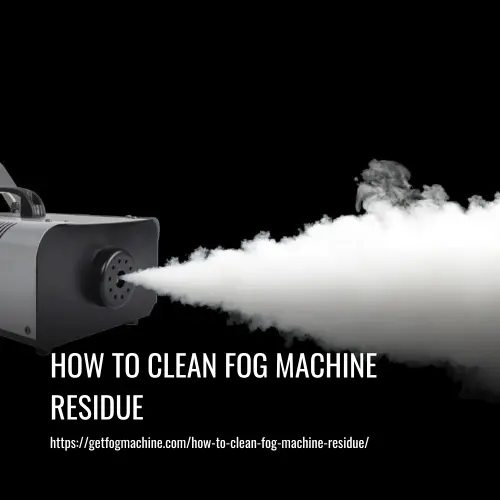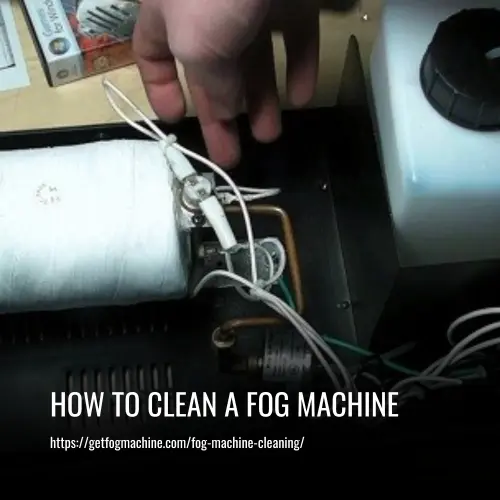How to Unclog a Fog Machine: A Step-by-Step Guide
This post contains affiliate links. As an Amazon Associate, we earn from qualifying purchases.
To unclog a fog machine, make a cleaning solution using equal parts distilled water and distilled white vinegar. Mix the two ingredients together and use this mixture to clean out the clogged parts of the fog machine. It’s important to use distilled water and not tap water for this solution.

The Importance Of Keeping The Machine Clean:
The importance of keeping your fog machine clean cannot be overstated. A clogged fog machine can cause poor performance and possible damage to the machine, so it’s important to regularly check and clean it.
- Efficiency: Regular cleaning ensures a consistent and even fog output. Dirt, debris, and residue can cause clogs and blockages that disrupt the fog-generation process. Prioritizing regular cleaning helps maintain the efficiency of your fog machine.
- Longevity: Cleaning your fog machine regularly helps prevent damage to its components. By removing dirt and residue, you can extend the lifespan of the machine and avoid costly repairs or replacements. Regular maintenance plays a crucial role in ensuring your fog machine lasts for an extended period of time.
- Safety: A clean fog machine reduces the risk of malfunctions, such as overheating or electrical issues. Regular maintenance minimizes the chance of accidents, ensuring a safe fog effect during use. Keep your fog machine in top shape to prioritize the safety of both yourself and your audience.
- Aesthetics: Cleaning your fog machine enhances its overall appearance. A dirty machine can be unappealing and may reflect poorly on your professionalism. Regular cleaning keeps your fog machine looking as good as new and helps you maintain a positive image.
Remember, a clean fog machine not only ensures optimal performance but also enhances the overall experience for your audience. Prioritize regular cleaning to keep your fog machine in top shape and enjoy consistent fog effects.
How To Tell If Your Fog Machine Is Clogged:
If you are experiencing issues with your fog machine, the first step is to determine whether it is clogged or not. Here are some signs that indicate a clog:
- Lack of fog output: If your fog machine is not producing any fog or the fog output is significantly reduced, it may be a sign of a clog.
- Uneven fog distribution: If the fog is not evenly distributed or comes out in bursts instead of a smooth flow, it could indicate a clog in the machine.
- Strange noises: If your fog machine is making unusual sounds like gurgling or grinding, it might be due to a clog in the internal mechanisms.
- Overheating: A clogged fog machine can lead to overheating, causing the machine to shut down or malfunction.
By keeping an eye out for these common symptoms, you can quickly identify if your fog machine is clogged and take the necessary steps to resolve the issue. Regular maintenance and cleaning can help prevent clogs and keep your fog machine running smoothly for optimal performance.
Why Does Your Fog Machine Get Clogged:
Your fog machine can get clogged due to various reasons. One common cause is the build-up of residue from fog fluid over time. As the fog fluid is dispersed, it leaves behind a sticky residue that can accumulate and clog the internal components of the machine.
Using the wrong type of fog fluid or failing to clean the machine properly after each use can also contribute to clogs. It is important to use high-quality fog fluid that is compatible with your machine and follow the manufacturer’s instructions for cleaning. Neglecting regular maintenance and cleaning can lead to clogging issues as well.
Environmental factors such as excessive dust or dirt in the surrounding area can find their way into the machine, further exacerbating clogging problems.
Cleaning The Fog Machine
Cleaning a clogged fog machine is essential for maintaining its performance and prolonging its lifespan. Here are the steps to effectively clean a fog machine:
- Safety first: Unplug the fog machine and wait for it to cool down completely before starting the cleaning process.
- Remove the fluid tank: Take out the fluid tank from the fog machine. Empty any remaining fog fluid and dispose of it properly.
- Clean the tank: Using a mixture of warm water and mild detergent, thoroughly clean the tank. Make sure to scrub off any residue or build-up inside the tank. Rinse it well with clean water and let it air dry.
- Unclog the nozzle: Take a cotton swab and soak it in the cleaning solution. Gently insert the cotton swab into the nozzle to clear any clogs. Be careful not to damage the delicate parts of the fog machine.
- Reassemble and test: Once everything is dry, reassemble the fog machine and double-check that all components are properly attached. Plug the machine into an electrical outlet and test it to ensure proper fog output.
Regular cleaning and maintenance are crucial for preventing clogs in the future. It is recommended to clean the fog machine after each use and inspect it for any damage or wear to address any issues promptly. By following these steps, you can keep your fog machine in optimal condition and enjoy its impressive fog effects without any interruptions.
How to Unclog a Clogged Fog Machine Heater:
If your fog machine heater has become clogged, it is important to address the issue quickly to prevent further damage to the machine. Here are the steps for unclogging a clogged fog machine heater.
- Power off and drain: First, unplug the fog machine from the power source and empty the reservoir of any fog juice. This will ensure your safety during the cleaning process.
- Fill reservoir: Fill the reservoir halfway with distilled water. Then, fill the remaining half with white vinegar. You can mix them together or add the vinegar directly after the water.
- Turn on and wait: Plug in the fog machine and turn it on. Allow it to run until fog starts to appear. This will help the vinegar break down any hardened particles clogging the machine’s intake system.
- Clean and refill: After the fog begins to appear, turn off the machine, unplug it, and empty the reservoir of the water-vinegar mixture. Refill the reservoir halfway with the recommended fog fluid provided by the manufacturer.
- Test and enjoy: Plug the fog machine back into the power source and let the heating element warm up. Turn on the machine and let it run until fog output is normal. Your fog machine should now be unclogged and ready to create atmospheric effects.
Remember to not use the fog machine when it is completely depleted, as this can damage the pump. Avoid using pure vinegar to unclog the machine, as it can harm the heating element. With these simple steps, you can easily unclog your fog machine heater and enjoy uninterrupted fog production.
How to Unclog The Pump:
The pump plays an important role in the operation of a fog machine and if it becomes clogged, your machine may not work properly. To unclog the pump, here are the steps you need to take:
- Turn off and unplug the fog machine: Prior to cleaning the pump, ensure that the fog machine is turned off and unplugged from the power source. This will prevent any accidents or electrical mishaps during the cleaning process.
- Locate the pump: Generally, the pump can be found near the fluid container of the fog machine. Look for screws or clips that secure the pump cover in place. Remove these screws or clips carefully to access the pump.
- Remove dirt and debris: Use a soft brush or cloth to gently remove any dirt or debris from the pump. Take caution not to damage any delicate components inside. Thoroughly clean the pump to ensure it is free from any clogs or obstructions.
- Soak in vinegar: Fill a container with distilled white vinegar and immerse the pump in the vinegar. Allow it to soak for about 10-15 minutes. The vinegar will dissolve any residue or buildup that may be causing the clog in the pump.
- Clean and rinse: After soaking, use a brush or cloth to clean the pump again, ensuring that it is free from any remaining dirt or vinegar. Rinse the pump thoroughly with clean water to remove any vinegar residue.
- Allow to dry: Allow the pump to dry completely before reinstalling the pump cover. This will prevent any moisture or water damage to the pump and ensure optimal performance.
- Test the pump: Once the pump is dry, reattach the pump cover and secure it with the screws or clips. Plug in the fog machine and test it to ensure that the pump is functioning properly. Check if the fog flows smoothly through the machine without any clogs or interruptions.
By following these steps, you can effectively unclog the pump of your fog machine and restore it to proper working condition. Regular cleaning and maintenance will help prolong the lifespan of your fog machine and ensure optimal performance for your atmospheric effects.
How Can You Prevent A Fog Machine From Clogging?
To prevent a fog machine from clogging, it is important to use high-quality fog juice specifically designed for your machine. Low-cost fog juice may not be compatible with your machine and can cause it to malfunction. High-quality fog juice is manufactured with safe ingredients that will not clog your machine if used properly.
It is worth investing in high-quality fog juice to ensure optimal performance and avoid future clogging issues. Regular maintenance and cleaning of your fog machine is also essential to prevent clogs. Make sure to clean the pump regularly by gently removing any dirt or debris with a soft brush or cloth.
Soaking the pump in distilled white vinegar for 10-15 minutes can help dissolve any residue or buildup that may be causing clogs. After soaking, thoroughly clean and rinse the pump with clean water to remove any vinegar residue.
Troubleshooting Common Issues with Your Fog Machine:
Despite regular maintenance and cleaning, fog machines can sometimes experience common issues that affect their performance. Here are some troubleshooting tips to help you address these problems:
Weak or Minimal Fog Output:
- Check Fog Fluid Level: Ensure that the fog fluid level in the machine’s tank is sufficient. If it’s low, refill it to the recommended level.
- Verify Heating Element: Make sure the fog machine’s heating element is properly connected and functioning. If it’s not heating up, the fog output may be weak or minimal.
- Remove Clogs or Debris: Clean the fog machine’s nozzle or output vent to eliminate any clogs or debris that may be obstructing the fog flow. Use a soft brush or cloth to gently remove any dirt or residue.
Excessive or Inconsistent Fog Output:
- Adjust Output Settings: If the fog output is too much or inconsistent, adjust the fog machine’s output settings to a lower level. This will help control the amount of fog being produced.
- Use Compatible Fog Fluid: Ensure that the fog fluid you are using is compatible with your fog machine. Different machines may require specific types or brands of fog fluid for optimal performance.
- Remove Blockages: Clean the fog machine’s nozzle and output vent to remove any blockages or obstructions that could be affecting the fog flow. This will help maintain a steady and consistent output.
Overheating or Unexpected Shut-Offs:
- Allow Cooling Down: If the fog machine overheats or shuts off unexpectedly, allow it to cool down for a few minutes before attempting to restart it. This will prevent further damage to the machine’s internal components.
- Check Temperature Limits: Consult the fog machine’s manual or manufacturer’s guidelines to check the temperature limits. Make sure you are not exceeding these limits during operation.
- Clean Internal Components: Clean the fog machine’s internal components, such as the pump and heating element, to remove any built-up residue or dirt that may be causing overheating. Regular cleaning and maintenance will help prolong the life of your fog machine.
By following these troubleshooting tips, you can quickly address common issues with your fog machine and ensure optimal performance for your next event or show.
Final Tips For Maintaining A Clean Fog Machine:
- Regular Cleaning: After each use, make sure to clean your fog machine properly. This will prevent clogs and extend the lifespan of your machine. Use a soft cloth or brush to remove any dirt or residue from the nozzle and output vent.
- Use High-Quality Fog Fluid: It’s important to use a high-quality fog fluid that is compatible with your fog machine. This will help minimize residue buildup and keep your machine running smoothly. Consult the manufacturer’s guidelines to ensure you are using the right type of fog fluid.
- Store in a Clean and Dry Environment: When not in use, store your fog machine in a clean and dry environment. This will prevent dust accumulation and moisture damage. Avoid storing it in areas with extreme temperatures or humidity.
- Follow Manufacturer’s Guidelines: Always follow the manufacturer’s guidelines for specific cleaning instructions and maintenance procedures. They know their machines best and can provide you with the most accurate information on how to care for your fog machine.
- Deep Clean with Cleaning Solution or Vinegar: Every few months, consider giving your fog machine a deep clean using a cleaning solution or vinegar mixture. This will help remove any built-up residue and keep your machine performing at its best. Consult the manufacturer’s guidelines for the recommended cleaning fluid.
- Keep Spare Parts on Hand: It’s a good idea to have spare parts, such as nozzles and seals, on hand in case any components wear out or get damaged. This will allow you to promptly replace them and avoid any downtime with your fog machine.
By following these final tips and properly maintaining your fog machine, you can ensure it remains clean, clog-free, and in good working condition. This will create an enchanting and immersive atmosphere for your events or performances.
FAQs
Yes, fog machines can clog up due to the thick fog fluid and high vaporization temperature. Over time, residue can build up in the machine, causing the nozzle to narrow and distort. This can result in decreased fog output and performance issues. Regular maintenance and cleaning can help prevent and resolve clogs.
Yes, you can run water through a fog machine to clean it. However, it is important to use distilled water to avoid mineral deposits that could potentially clog the machine further. Follow the manufacturer’s guidelines for specific cleaning instructions to ensure proper cleaning and maintenance.
There could be several reasons why your fog machine is not producing fog. One common issue is clogs in the machine. The thick consistency of fog fluid combined with the high vaporization temperature can lead to clogs over time. Cleaning the fog machine should solve the problem and restore normal fog output. It’s important to regularly maintain and clean your fogger to keep it performing at its best.
Regularly cleaning your fog machine has several benefits. If your fog machine is not cleaned on a regular basis, residue can build up and clog the nozzle, resulting in decreased fog output and performance deterioration. Cleaning your fog machine removes this buildup, ensuring that the fluid can flow easily and freely through the nozzles. After cleaning the fog machine, it is also recommended to run it for a few minutes to ensure that it is functioning properly.
If your fog machine is used often, it is recommended to clean it after approximately 72 hours of operation. However, it is important to note that running the fog machine for a few extra hours without cleaning will not cause major issues. It is also important to never put away a cleaned fog machine right away. Whenever possible, fill the machine with fog fluid and run it for a few minutes to create fog before storing it. This helps maintain the machine’s functionality and prevents potential clogs from forming during storage.
Conclusion:
With these simple steps, you can easily unclog a fog machine and get back to creating a mesmerizing atmosphere at your next event. Don’t let a clogged machine dampen your spirits – take charge and keep the fog flowing!
Remember, a little maintenance goes a long way in ensuring your fog machine keeps the party going. So, grab your tools and get ready to banish the clog – it’s time to bring the fog back!






